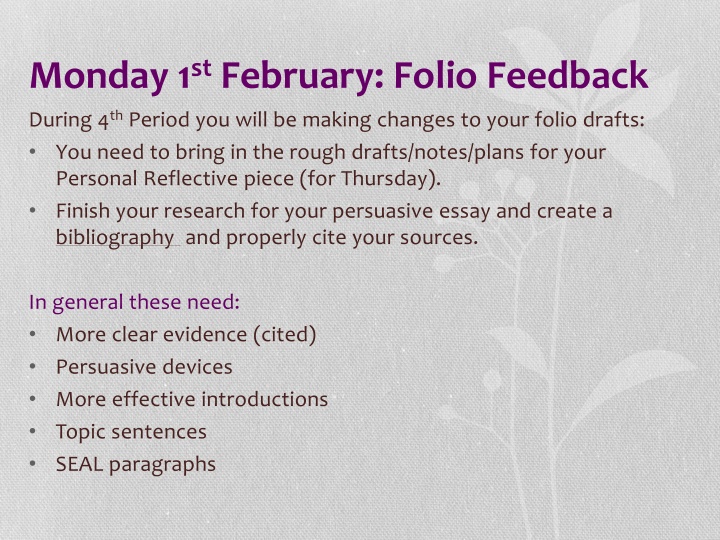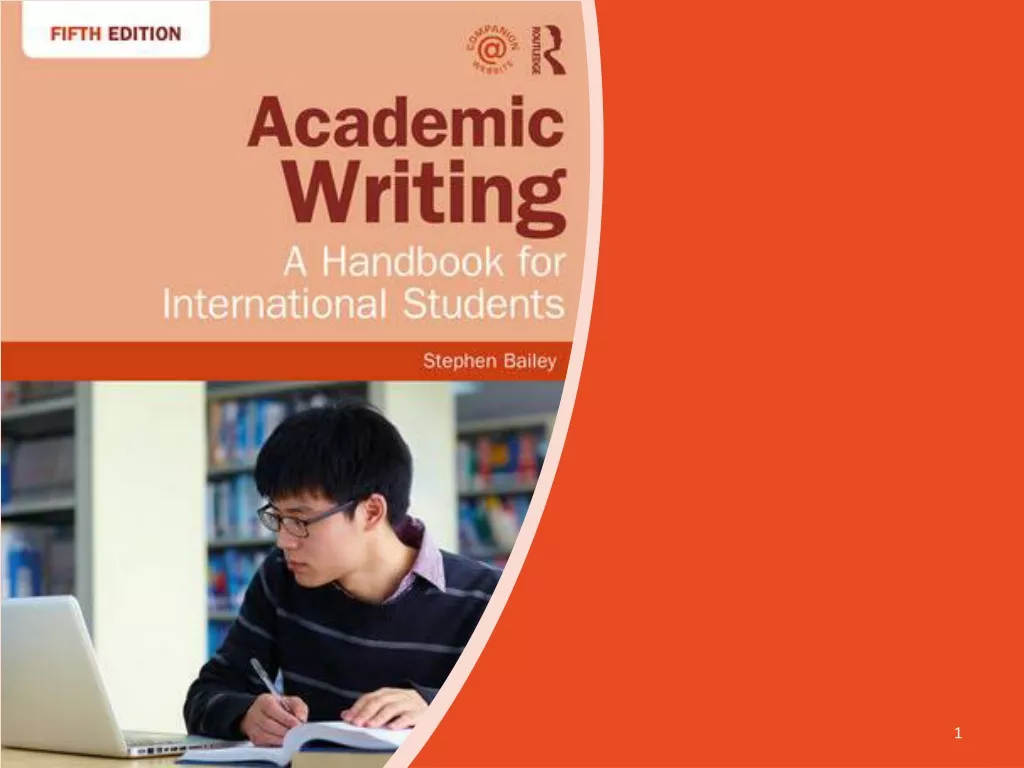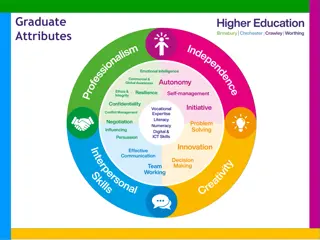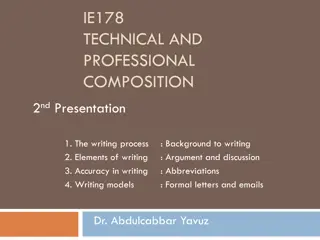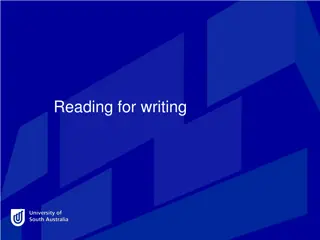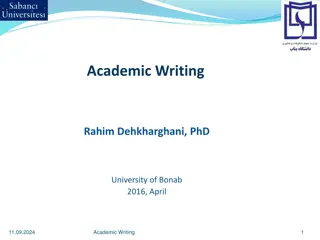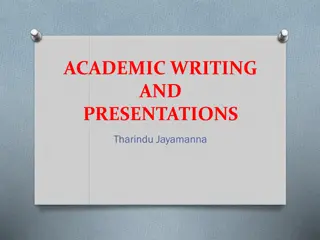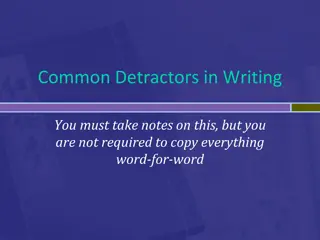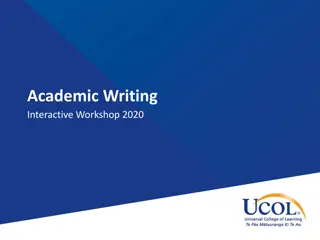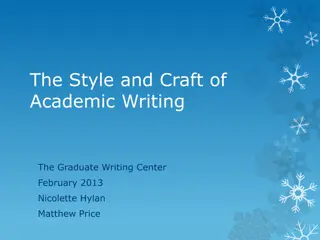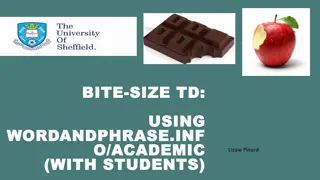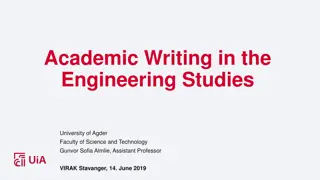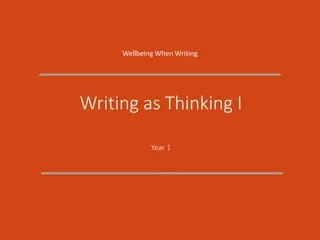Enhancing Your Writing Skills for Academic Success
Improve your folio drafts by focusing on key elements such as clear evidence, persuasive devices, effective introductions, and topic sentences. Explore examples of outstanding folios and learn how to create impactful content with proper citations and bibliography. Discover ways to make a lasting impression on your readers through dramatic impact and persuasive strategies. Master the art of crafting compelling introductions and elevate your writing for success.
Uploaded on Sep 30, 2024 | 1 Views
Download Presentation

Please find below an Image/Link to download the presentation.
The content on the website is provided AS IS for your information and personal use only. It may not be sold, licensed, or shared on other websites without obtaining consent from the author.If you encounter any issues during the download, it is possible that the publisher has removed the file from their server.
You are allowed to download the files provided on this website for personal or commercial use, subject to the condition that they are used lawfully. All files are the property of their respective owners.
The content on the website is provided AS IS for your information and personal use only. It may not be sold, licensed, or shared on other websites without obtaining consent from the author.
E N D
Presentation Transcript
Monday 1stFebruary: Folio Feedback During 4thPeriod you will be making changes to your folio drafts: You need to bring in the rough drafts/notes/plans for your Personal Reflective piece (for Thursday). Finish your research for your persuasive essay and create a bibliography and properly cite your sources. In general these need: More clear evidence (cited) Persuasive devices More effective introductions Topic sentences SEAL paragraphs
Outstanding Folios Creative: Jay Alexander Craig Ballantyne Harry Chalmers Fergus Watson Persuasive: Jay Alexander Craig Ballantyne Amy Black Emira Grant Harry Chalmers Tim Shoreman Cameron Stuart Fergus Watson Erin McPake Check folders and bags! I need to see a plan for these by tomorrow so that we can set time aside to do the writing.
Topic Sentences USE THEM! This briefly states what your paragraph will be about. Remember that a paragraph should centre around just ONE idea. Topic Sentence: To be an effective CEO requires certain characteristics. The topic is To be an effective CEO and the controlling idea is certain characteristics. Topic Sentence: There are many possible contributing factors to global warming. The topic is "contributing factors to global warming" and the controlling factor is "many reasons." Topic Sentence: Fortune hunters encounter many difficulties when exploring a shipwreck. The topic is exploring a shipwreck and the controlling idea is many difficulties. Topic Sentence: Dogs make wonderful pets because they help you to live longer. The topic is "dogs make wonderful pets" and the controlling idea is "because they help you to live longer."
Bibliography BOOKS Authors name(s) in italics, Title of Book, Publisher, Date of publication. WEBSITES Name of website with date of production (if known) in brackets, name of article (if known), full URL with [date accessed in square brackets] e.g.
Ways to Make Impact Dramatic impact emotive words forceful phrases contrasts play on the reader s guilt imagery exaggeration (hyperbole) shock tactics Logic quote a reliable source statistics criticise the opposite opinion make negative points impersonal Stylistic tricks clusters of three catchy phrases or slogans figures of speech short sentences/ paragraphs rhetorical questions repetition of words/ phrases
Introductions You should aim for this to be no more than one-tenth of the word limit. A successful introduction will: Set out the topic clearly Give an indication of the current importance of the topic Set out a few facts which will contextualise the topic Give some indication of the main aspects to be studied At this level, there should be no need to make statements like This essay will . . . . Also avoid any lengthy explorations of the history of your topic
Conclusions In your conclusion, include an overview of the main arguments with perhaps one main idea from each paragraph. Don t just list them and state where your opinion lies. Conclude strongly by evaluating the nature of the arguments and make a final statement of conviction.
'THE FLOWERS' BY ALICE WALKER Critical Essay Short Story 2
Learning Intentions By the end of this lesson you should be able to show your understanding of the plot of the story. understand the writer s use of turning point, mood and symbolism, and be able to explain how these are created in a story.
Reading the Story As we read the short story together, underline (in pencil) the key elements of the plot. You should be able to answer these questions: Who is the main character? What do we learn about her? Where is the setting? What happens to the character? What do you think is the theme of this story?
Literary Terms to Know Homework: FAMILIARISE YOURSELVES WITH THEM. imagery the use of vivid language to create images in the reader s mind. symbol something that stands for itself and something else. setting the time and place in which a story occurs. narrative pace the speed at which an author tells a story; the movement from one point or section to another. diction the choice of words used in a literary work. style A writer s way of saying things, or a philosophy that influences the author s viewpoint. theme an abstract idea that emerges from a literary work s treatment of its subject matter, or a topic recurring in a number of literary works.. Themes include love, war, revenge, betrayal, fate, etc. epiphany an illuminating discovery, realization, or disclosure.
The Plot Write yourself a short plot summary using the questions to format your answer. Myop is ten years old and lives in the country. She is very observant of nature: animals, plants (especially flowers). She loves the world and displays childish innocence. When she goes on her daily walk through the woods (collecting flowers) she strays further than she normally would. She becomes entangled with a dead body and drops her flowers.
The Setting: Sharecroppers Despite giving African Americans the rights of citizens after the Civil War, the federal government (and the Republican-controlled state governments formed during this phase of Reconstruction) took little concrete action to help freed blacks in the quest to own their own land. Instead of receiving wages for working an owner s land and having to submit to supervision and discipline most freedmen preferred to rent land for a fixed payment rather than receive wages. By the early 1870s, the system known as sharecropping had come to dominate agriculture across the cotton-planting South. Under this system, black families would rent small plots of land, or shares, to work themselves; in return, they would give a portion of their crop to the landowner at the end of the year. (http://www.history.com/topics/black-history/sharecropping) How does this help us to understand who Myop is?
The Setting: Lynching In the last decades of the nineteenth century, the lynching of black people in the Southern and border states became an institutionalized method used by whites to terrorize Blacks and maintain white supremacy. In the South, during the period 1880 to 1940, there was deep-seated and all-pervading hatred and fear of black people which led white mobs to turn to lynch law as a means of social control. Most of the lynchings were by hanging or shooting, or both. However, many were of a more hideous nature burning at the stake, maiming, dismemberment, castration, and other brutal methods of physical torture. Lynching therefore was a cruel combination of racism and sadism, which was utilized primarily to sustain the caste system in the South. Many white people believed that black people could only be controlled by fear. To them, lynching was seen as the most effective means of control. How does this help us to understand who the body might have been?
The Turning Point A turning point in a story is the point when there is a significant change in the way a character is thinking or behaving, in the mood or atmosphere of the story, in the tension and so on. Decide where in the turning point occurs in The Flowers . Be prepared to explain your reasoning to the class. Draw a line across the page at this point to cut the story in two.
Mood: a literary element that evokes certain feelings or vibes in readers through words and descriptions. Turning Point and Mood In your pairs, one will look at the first part of the story, and one will look at the second half the separation will be the turning point. We are going to look at how the author creates mood. By the end of this activity you should be able to answer: How does the turning point influence the mood of the story?
Turning Point and Mood For your section of the story, highlight the following: references to light and colour references to setting references to Myop s actions. In pairs, discuss how these references create mood. Share your highlighting so both parts of the story are highlighted appropriately.
Symbolism Symbolism: the use of symbols to represent ideas or qualities. Symbolism can be found in colours: Black is sometimes used to represent death or evil. White stands for life and purity. Red can symbolize blood, passion, danger, or immoral character. Symbolism can be found in objects: Roses stand for romance. A dove is a symbol of peace.
Symbolism: Flowers In the story, flowers could be said to be symbolic, i.e. they are used to represent an idea. For your half of the story, find all the references to flowers and highlight these. Think about what s happening at the point in the story when flowers are mentioned, and discuss what the flowers might represent. Write notes in the margin. Then swap with each other so that you have both sections highlighted.
In pairs, work through all the references to flowers in the story, and complete a table like this one. You should quote the reference, describe what is happening in the story at that time, and then comment on what the flowers could represent/symbolise. Reference to flowers What s happening in the story What the flowers might represent 'silver ferns and wildflowers grew' Myop is near her home and picking flowers Wildflowers represent her desire for adventure. Ferns the protection of her home.
Sample Analysis of the Symbolism of the Flower Flowers are an important symbol in the story, representing the beauty and sweetness of innocence, ignorance and youth. Myop carries flowers with her that are as beautiful and unknowing as she is herself about the harsh world and all of its cruelties. Even the wildflower that is sprouting out of the middle of the noose is completely oblivious to the violence and death that had occurred so close by. Myop is the same way; she is young, naive, and completely oblivious to the fact that many people were lynched and hanged, simply because they were black, people that she might have known, that lived close to her. So, the flowers symbolize that unknowing beauty that childhood often possesses. Then, at the end, when it says Myop laid down her flowers, it symbolizes how she laid down her innocence and childhood. She turned a corner to adulthood and was never able to go back. Giving up the flowers meant that she was also leaving behind her naivety and ignorance.
Myop Find and make a list of words that describe Myop s innocence: skipped lightly . . . Her reaction to the body: Myop gazed around the spot with interest How does Myop react when she sees the body? Why is this odd? What does this suggest about her as a character? Myopia : the quality of being short-sighted. What hints do we have that Myop may not be able to see well? How does this help us to understand the character of Myop? What does this tell us about the overall theme of the story?
Symbolism: Summer What does summer generally represent? Happiness Growth Freedom Young adulthood life in full swing Sun (brightness) Clarity mean? What does the end of Myop s summer represent? And the summer was over. What does this quote actually Find and list quotes from the passage that represent this view of summer: golden surprise the days had never been as beautiful as these The air held a keenness She felt light and good in the warm sun
Group Analysis Make notes on the following on your sheet of paper: How does Walker create mood, use a turning point and use symbolism in her story? You should discuss and note down as much as you can, using quotations, analysis and evaluation.
Self-evaluation Answers these questions on the post-it note, and be honest: How well do I understand mood, turning point and symbolism in this story? How well do I think I understand these terms in general? How well did I work in pairs/groups?
Essay Questions Choose a novel or a short story or a work of non-fiction which explores an important theme. By referring to appropriate techniques, show how the author has explored this theme. Choose a novel or short story or work of non-fiction which has a key incident. Give a brief account of the incident, and by referring to appropriate techniques, show how this incident is important to the text as a whole.
Topic Sentences When following a SEAL structure for your critical essay, your Statement is a TOPIC SENTENCE. It tells the marker what you will be looking at in the paragraph, and should refer to the essay question. E.g. Choose a novel or a short story or a work of non-fiction which explores an important theme. By referring to appropriate techniques, show how the author has explored this theme. Example topic sentences: Walker also explores Myop s loss of innocence through her clever use of changing mood in the short story. Furthermore, Walker goes on to use symbolism to emphasise the loss of innocence in The Flowers. As well as this, Myop s loss of innocence is highlighted again through the imagery Walker uses throughout the short story.
